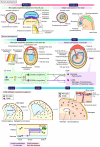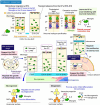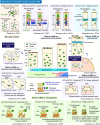Physiological roles of embryonic microglia and their perturbation by maternal inflammation
- PMID: 40260079
- PMCID: PMC12009865
- DOI: 10.3389/fncel.2025.1552241
Physiological roles of embryonic microglia and their perturbation by maternal inflammation
Abstract
The interplay between the nervous and immune systems is well documented in the context of adult physiology and disease. Recent advances in understanding immune cell development have highlighted a significant interaction between neural lineage cells and microglia, the resident brain macrophages, during developmental stages. Throughout development, particularly from the embryonic to postnatal stages, diverse neural lineage cells are sequentially generated, undergo fate determination, migrate dynamically to their appropriate locations while maturing, and establish connections with their surroundings to form neural circuits. Previous studies have demonstrated that microglia contribute to this highly orchestrated process, ensuring the proper organization of brain structure. These findings underscore the need to further investigate how microglia behave and function within a broader framework of neurodevelopment. Importantly, recent epidemiological studies have suggested that maternal immune activation (MIA), triggered by various factors, such as viral or bacterial infections, environmental stressors, or other external influences, can affect neurogenesis and neural circuit formation, increasing the risk of neurodevelopmental disorders (NDDs) in offspring. Notably, many studies have revealed that fetal microglia undergo significant changes in response to MIA. Given their essential roles in neurogenesis and vascular development, inappropriate activation or disruption of microglial function may impair these critical processes, potentially leading to abnormal neurodevelopment. This review highlights recent advances in rodent models and human studies that have shed light on the behaviors and multifaceted roles of microglia during brain development, with a particular focus on the embryonic stage. Furthermore, drawing on insights from rodent MIA models, this review explores how MIA disrupts microglial function and how such disturbances may impair brain development, ultimately contributing to the onset of NDDs.
Keywords: brain; development; maternal immune activation; maternal inflammation; microglia; neurodevelopmental disorder; neuron; psychiatric disorder.
Copyright © 2025 Shimamura, Kitashiba, Nishizawa and Hattori.
Conflict of interest statement
The authors declare that the research was conducted in the absence of any commercial or financial relationships that could be construed as a potential conflict of interest.
Figures



Similar articles
-
Maternal immune activation alters fetal and neonatal microglia phenotype and disrupts neurogenesis in mice.Pediatr Res. 2023 Apr;93(5):1216-1225. doi: 10.1038/s41390-022-02239-w. Epub 2022 Aug 13. Pediatr Res. 2023. PMID: 35963885
-
The Outcomes of Maternal Immune Activation Induced with the Viral Mimetic Poly I:C on Microglia in Exposed Rodent Offspring.Dev Neurosci. 2023;45(4):191-209. doi: 10.1159/000530185. Epub 2023 Mar 21. Dev Neurosci. 2023. PMID: 36944325 Review.
-
Maternal immune activation-induced PPARγ-dependent dysfunction of microglia associated with neurogenic impairment and aberrant postnatal behaviors in offspring.Neurobiol Dis. 2019 May;125:1-13. doi: 10.1016/j.nbd.2019.01.005. Epub 2019 Jan 17. Neurobiol Dis. 2019. PMID: 30659984
-
The impact of maternal immune activation on embryonic brain development.Front Neurosci. 2023 Mar 6;17:1146710. doi: 10.3389/fnins.2023.1146710. eCollection 2023. Front Neurosci. 2023. PMID: 36950133 Free PMC article. Review.
-
Maternal immune activation altered microglial immunoreactivity in the brain of postnatal day 2 rat offspring.Synapse. 2018 Sep 26:e22072. doi: 10.1002/syn.22072. Online ahead of print. Synapse. 2018. PMID: 30256454
Cited by
-
Contemporary insights into neuroimmune interactions across development and aging.Front Neurol. 2025 Jul 25;16:1611124. doi: 10.3389/fneur.2025.1611124. eCollection 2025. Front Neurol. 2025. PMID: 40786636 Free PMC article. Review.
References
Publication types
LinkOut - more resources
Full Text Sources

